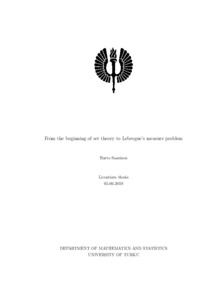From the beginning of set theory to Lebesgue’s measure problem
Saarinen, Harto (2020-01-16)
From the beginning of set theory to Lebesgue’s measure problem
Saarinen, Harto
(16.01.2020)
Turun yliopisto
Julkaisun pysyvä osoite on:
https://urn.fi/URN:NBN:fi-fe202001162326
https://urn.fi/URN:NBN:fi-fe202001162326
Tiivistelmä
Descriptive set theory has its origins in Cantor’s work on pointsets in the 1870s. Cantor’s construction of real numbers and proof of the non-denumerability of real numbers were the first results towards a new theory. Later, in 1878, Cantor formulated his continuum hypothesis for the first time, which lead to the first result in descriptive set theory: the Cantor-Bendixson theorem.
Two decades later, Cantor’s theory awoke interest in French analysts Borel, Baire and Lebesgue. Their work on measure theory and classification of functions rested heavily on Cantorian ideas. The most important problem for the development of descriptive set theory was Lebesgue’s measure problem: which subsets of the real line are Lebesgue measurable?
After Vitali’s impossibility result in 1904 and Zermelo’s axiomatization of set theory ZFC in 1908 Lebesgue’s measure problem gained, in addition to its mathematical framework, a philosophical one as well. This allowed for a better understanding of the underlying situation and also proof-theoretic considerations. The limit to what could be proved to be measurable in ZFC was soon achieved.
However, new ideas arose through the works of Banach and Ulam. Their more general measure problem was identified as being dependant on strong axioms of infinity, the large cardinals, which are still linked to real numbers. Cantor’s theory of cardinal numbers had thus found applications even at the level of real numbers. Cantor konstruoi reaaliluvut ensimmäistä kertaa 1870-luvun alussa ja osoitti, että ne muodostavat ylinumeroituvan joukon. Myöhemmin vuonna 1878 Cantor esitti kontinuumihypoteesin, joka johti kuvailevan joukko-opin syntyyn sekä ensimmäiseen tulokseen – Cantor–Bendixsonin lauseeseen.
Kaksi vuosikymmentä myöhemmin Cantorin työ sai huomiota Ranskassa. Ranskalaisten matematiikkojen Borelin, Bairen ja Lebesguen ideoissa mittateoriassa ja funktioiden luokittelussa hyödynnettiin laajasti Cantorin ajatuksia. Tärkeimmäksi yksittäiseksi ongelmaksi kuvailevassa joukko-opissa muodostui Lebeguen mittaongelma: mitkä reaalilukujen osajoukot ovat Lebesgue mitallisia?
Vital näytti vuonna 1904 vedoten valinta-aksioomaan, että on olemassa reaalilukujen osajoukko, joka ei ole mitallinen. Tämän tuloksen ja Zermelon vuonna 1908 esittämien joukko-opin aksioomien myötä Lebesguen mittaongelma sai matemaattisen näkökulman lisäksi myös filosofisen. Seuraavien vuosikymmenten aikana osoitettiin, että Zermelon aksioomien avulla ei voida vastata moniin keskeisiin joukko-opin kysymyksiin.
Banach ja Ulam onnistuivat kehittämään uusia aksioomia näiden ongelmien ratkaisemiseksi. Osoittautui, että heidän esittämä yleisempi mittaongelma riippuu voimakkaista suurten kardinaliteettien aksioomista. Täten Cantorin kardinaalilukujen teorialle löytyi sovelluksia jopa reaalilukujen osajoukoille.
Two decades later, Cantor’s theory awoke interest in French analysts Borel, Baire and Lebesgue. Their work on measure theory and classification of functions rested heavily on Cantorian ideas. The most important problem for the development of descriptive set theory was Lebesgue’s measure problem: which subsets of the real line are Lebesgue measurable?
After Vitali’s impossibility result in 1904 and Zermelo’s axiomatization of set theory ZFC in 1908 Lebesgue’s measure problem gained, in addition to its mathematical framework, a philosophical one as well. This allowed for a better understanding of the underlying situation and also proof-theoretic considerations. The limit to what could be proved to be measurable in ZFC was soon achieved.
However, new ideas arose through the works of Banach and Ulam. Their more general measure problem was identified as being dependant on strong axioms of infinity, the large cardinals, which are still linked to real numbers. Cantor’s theory of cardinal numbers had thus found applications even at the level of real numbers.
Kaksi vuosikymmentä myöhemmin Cantorin työ sai huomiota Ranskassa. Ranskalaisten matematiikkojen Borelin, Bairen ja Lebesguen ideoissa mittateoriassa ja funktioiden luokittelussa hyödynnettiin laajasti Cantorin ajatuksia. Tärkeimmäksi yksittäiseksi ongelmaksi kuvailevassa joukko-opissa muodostui Lebeguen mittaongelma: mitkä reaalilukujen osajoukot ovat Lebesgue mitallisia?
Vital näytti vuonna 1904 vedoten valinta-aksioomaan, että on olemassa reaalilukujen osajoukko, joka ei ole mitallinen. Tämän tuloksen ja Zermelon vuonna 1908 esittämien joukko-opin aksioomien myötä Lebesguen mittaongelma sai matemaattisen näkökulman lisäksi myös filosofisen. Seuraavien vuosikymmenten aikana osoitettiin, että Zermelon aksioomien avulla ei voida vastata moniin keskeisiin joukko-opin kysymyksiin.
Banach ja Ulam onnistuivat kehittämään uusia aksioomia näiden ongelmien ratkaisemiseksi. Osoittautui, että heidän esittämä yleisempi mittaongelma riippuu voimakkaista suurten kardinaliteettien aksioomista. Täten Cantorin kardinaalilukujen teorialle löytyi sovelluksia jopa reaalilukujen osajoukoille.
